High Nature Value Farming Systems and Protected Areas: Conservation Opportunities or Land Abandonment? A Study Case in the Madrid Region (Spain)
Abstract
:1. Introduction
2. Materials and Methods
2.1. Study Area
2.2. Selection of Land Analysis Units
2.3. Data Collection
2.4. Data Analyses
3. Results
3.1. High Nature Value Farmlands and Landscape Dynamic
3.2. Socioeconomic Dimensions of the Rural Landscape
3.3. National Park Establishment. Social-Ecological Conditions of a Changing Protected Landscape
4. Discussion
5. Conclusions
Author Contributions
Funding
Institutional Review Board Statement
Informed Consent Statement
Data Availability Statement
Acknowledgments
Conflicts of Interest
Appendix A
| Municipalities | Municipality Code | Municipal Area within Regional Park Boundaries (%) | Municipal Area within Natural Park Boundaries (%) | Municipal Area within SG National Park Boundaries (%) | Municipal Area within Peripheral Protection Zone of National Park (%) |
|---|---|---|---|---|---|
| Alameda del Valle | 1 | 0.0 | 0.0 | 25.5 | 72.4 |
| Alcobendas * | 2 | 10.2 | - | 0.0 | 0.0 |
| Algete * | 3 | 0.0 | - | 0.0 | 0.0 |
| Alpedrete * | 4 | 0.0 | - | 0.0 | 0.0 |
| Becerril de la Sierra | 5 | 57.6 | - | 20.9 | 16.2 |
| El Boalo | 6 | 75.3 | - | 16.8 | 26.0 |
| Bustarviejo * | 7 | 0.0 | - | 0.0 | 0.0 |
| Canencia de la Sierra | 8 | 0.0 | - | 0.0 | 82.6 |
| Cercedilla | 9 | 62.6 | - | 28.1 | 52.1 |
| Colmenar Viejo | 10 | 29.6 | - | 0.0 | 0.0 |
| Collado Mediano * | 11 | 0.0 | - | 0.0 | 0.0 |
| Collado Villalba | 12 | 38.1 | - | 0.0 | 0.0 |
| Galapagar * | 13 | 7.3 | - | 0.0 | 0.0 |
| Garganta de los Montes * | 14 | 0.0 | - | 0.0 | 0.0 |
| Gargantilla del Lozoya * | 15 | 0.0 | - | 0.0 | 0.0 |
| Guadarrama * | 16 | 0.0 | - | 0.0 | 1.3 |
| Hoyo de Manzanares | 17 | 100.0 | - | 0.0 | 0.0 |
| Lozoya | 18 | 0.0 | - | 22.3 | 74.1 |
| Majadahonda * | 19 | 0.0 | - | 0.0 | 0.0 |
| Manzanares el Real | 20 | 98.9 | - | 55.0 | 11.3 |
| Miraflores de la Sierra | 21 | 52.7 | - | 7.3 | 48.2 |
| El Molar * | 22 | 0.0 | - | 0.0 | 0.0 |
| Los Molinos * | 23 | 0.1 | - | 0.0 | 44.1 |
| Moralzarzal | 24 | 64.5 | - | 0.0 | 0.0 |
| Navacerrada | 25 | 64.1 | - | 32.9 | 36.6 |
| Navalafuente * | 26 | 0.0 | - | 0.0 | 0.0 |
| Navarredonda y San Mamés | 27 | 0.0 | - | 3.6 | 27.3 |
| Pedrezuela * | 28 | 0.0 | - | 0.0 | 0.0 |
| Pinilla del Valle | 29 | 0.0 | - | 27.6 | 71.4 |
| Rascafría | 30 | 0.0 | 100.0 | 52.8 | 43.7 |
| Las Rozas de Madrid | 31 | 37.0 | - | 0.0 | 0.0 |
| San Agustín de Guadalix * | 32 | 0.1 | - | 0.0 | 0.0 |
| San Sebastián de los Reyes * | 33 | 14.9 | - | 0.0 | 0.0 |
| Soto del Real | 34 | 43.9 | - | 3.6 | 27.3 |
| Torrelodones | 35 | 58.3 | - | 0.0 | 0.0 |
| Tres Cantos | 36 | 100.0 | - | 0.0 | 0.0 |
| El Vellón * | 37 | 0.0 | - | 0.0 | 0.0 |
| Villanueva del Lozoya * | 38 | 0.0 | - | 0.0 | 0.0 |
References
- Petrosillo, I.; Aretano, R.; Zurlini, G. Socioecological systems. Encycl. Ecol. 2015, 4, 419–425. [Google Scholar]
- Antrop, M. Why landscapes of the past are important for the future. Landsc. Urban Plan 2005, 70, 21–34. [Google Scholar] [CrossRef]
- Marull, J.; Tello, E.; Fullana, N.; Murray, I.; Jover, G.; Font, C.; Coll, F.; Domene, E.; Leoni, V.; Decolli, T. Long-term bio-cultural heritage: Exploring the intermediate disturbance hypothesis in agroecological landscapes (Mallorca, c. 1850–2012). Biodivers. Conserv. 2015, 24, 217–3251. [Google Scholar]
- Vlami, V.; Kokkoris, I.P.; Zogaris, S.; Cartalis, C.; Kehayias, G.; Dimopoulos, P. Cultural landscapes and attributes of “culturalness” in protected areas: An exploratory assessment in Greece. Sci. Total Environ. 2017, 595, 229–243. [Google Scholar] [CrossRef] [PubMed]
- Berkes, F.; Colding, J.; Folke, C. Rediscovery of Traditional Ecological Knowledge as adaptive management. Ecol. Appl. 2000, 10, 1251–1262. [Google Scholar] [CrossRef]
- Hernández-Morcillo, M.; Hoberg, J.; Oteros-Rozas, E.; Plieninger, T.; Gómez-Baggethun, E.; Reyes-García, V. Traditional ecological knowledge in Europe: Status quo and insights for the environmental policy agenda. Environ. Sci. Policy Sustain. Dev. 2014, 56, 3–17. [Google Scholar] [CrossRef] [Green Version]
- Agnoletti, M. Rural landscape, nature conservation and culture: Some notes on research trends and management approaches from a (southern) European perspective. Landsc. Urban Plan 2014, 126, 66–73. [Google Scholar] [CrossRef]
- Agnoletti, M.; Tredici, M.; Santoro, A. Biocultural diversity and landscape patterns in three historical rural areas of Morocco, Cuba and Italy. Biodivers. Conserv. 2015, 24, 3387–3404. [Google Scholar] [CrossRef]
- Fischer, J.; Hartel, T.; Kuemmerle, T. Conservation policy in traditional farming landscapes. Conserv. Lett. 2012, 5, 167–175. [Google Scholar] [CrossRef] [Green Version]
- Sutcliffe, L.M.; Batáry, P.; Kormann, U.; Báldi, A.; Dicks, L.V.; Herzon, I.; Kleijn, D.; Tryjanowski, P.; Apostolova, I.; Arlettaz, R.; et al. Harnessing the biodiversity value of Central and Eastern European farmland. Divers. Distrib. 2015, 21, 722–730. [Google Scholar] [CrossRef] [Green Version]
- Campedelli, T.; Calvi, G.; Rossi, P.; Trisorio, A.; Florenzano, G.T. The role of biodiversity data in High Nature Value Farmland areas identification process: A case study in Mediterranean agrosystems. J. Nat. Conserv. 2018, 46, 66–78. [Google Scholar] [CrossRef]
- Plieninger, T.; Torralba, M.; Hartel, T.; Fagerholm, N. Perceived ecosystem services synergies, trade-offs, and bundles in European high nature value farming landscapes. Landsc. Ecol. 2019, 34, 1565–1581. [Google Scholar] [CrossRef]
- Bignal, E.M.; Mccraken, D.I. The nature conservation value of European traditional farming systems. Environ. Rev. 2000, 8, 149–171. [Google Scholar] [CrossRef]
- Phillips, A. The nature of cultural landscapes—A nature conservation perspective. Landsc. Res. 1998, 23, 21–38. [Google Scholar] [CrossRef]
- Antrop, M. Rural-urban conflicts and opportunities. In The New Dimensions of the European Landscape; Jongman, R.H.G., Ed.; Springer: Dordrecht, The Netherlands, 2004; pp. 83–91. [Google Scholar]
- Antrop, M. Sustainable landscapes: Contradiction, fiction or utopia? Landsc. Urban Plan 2006, 75, 187–197. [Google Scholar] [CrossRef]
- Plieninger, T.; Höchtl, F.; Spek, T. Traditional land-use and nature conservation in European rural landscapes. Environ. Sci. Policy 2006, 9, 317–321. [Google Scholar] [CrossRef]
- Antrop, M.; Van Eetvelde, V. Mechanisms in recent landscape transformation. WIT Trans. Built Environ. 2008, 100, 183–192. [Google Scholar]
- Arnaiz-Schmitz, C.; Schmitz, M.F.; Herrero-Jáuregui, C.; Gutiérrez-Angonese, J.; Pineda, F.D.; Montes, C. Identifying socio-ecological networks in rural-urban gradients: Diagnosis of a changing cultural landscape. Sci. Total Environ. 2018, 612, 625–635. [Google Scholar] [CrossRef] [PubMed]
- Arnaiz-Schmitz, C.; Herrero-Jáuregui, C.; Schmitz, M.F. Losing a heritage hedgerow landscape. Biocultural diversity conservation in a changing social-ecological Mediterranean system. Sci. Total Environ. 2018, 637, 374–384. [Google Scholar] [CrossRef] [PubMed]
- Cumming, G.S.; Allen, C.R. Protected areas as social-ecological systems: Perspectives from resilience and social-ecological systems theory. Ecol. Appl. 2017, 27, 1709–1717. [Google Scholar] [CrossRef]
- Sarmiento-Mateos, P.; Arnaiz-Schmitz, C.; Herrero-Jáuregui, C.; Pineda, F.D.; Schmitz, M.F. Designing Protected Areas for Social–Ecological Sustainability: Effectiveness of Management Guidelines for Preserving Cultural Landscapes. Sustainability 2019, 11, 2871. [Google Scholar] [CrossRef] [Green Version]
- Verdú, J.R.; Crespo, M.B.; Galante, E. Conservation strategy of a nature reserve in Mediterranean ecosystems: The effects of protection from grazing on biodiversity. Biodivers. Conserv. 2000, 9, 1707–1721. [Google Scholar] [CrossRef]
- Sims, K.R.E. Conservation and development: Evidence from Thai protected areas. J. Environ. Econ. Manag. 2010, 60, 94–114. [Google Scholar] [CrossRef]
- Schmitz, M.F.; Matos, D.G.G.; De Aranzabal, I.; Ruiz-Labourdette, D.; Pineda, F.D. Effects of a protected area on land-use dynamics and socioeconomic development of local populations. Biol. Conserv. 2012, 149, 122–135. [Google Scholar] [CrossRef]
- Schmitz, M.F.; Herrero-Jáuregui, C.; Arnaiz-Schmitz, C.; Sánchez, I.A.; Rescia, A.J.; Pineda, F.D. Evaluating the Role of a Protected Area on Hedgerow Conservation: The Case of a Spanish Cultural Landscape. Land Degrad. Dev. 2017, 28, 833–842. [Google Scholar] [CrossRef]
- Pereira, H.M.; Navarro, L.M. Rewilding European Landscapes; Springer International Publishing: New York, NY, USA, 2015. [Google Scholar]
- Wallsten, P. The “inside-out” process: A key approach for establishing Fulufjället National Park in Sweden. Mt. Res. Dev. 2003, 23, 227–229. [Google Scholar] [CrossRef]
- Alo, C.A.; Pontius, R.G., Jr. Identifying systematic land-cover transitions using remote sensing and GIS: The fate of forests inside and outside protected areas of Southwestern Ghana. Environ. Plan. B Plan. Des. 2008, 35, 280–295. [Google Scholar] [CrossRef]
- Western, D.; Russell, S.; Cuthill, I. The status of wildlife in protected areas compared to non-protected areas of Kenya. PLoS ONE 2009, 4, e6140. [Google Scholar] [CrossRef] [PubMed] [Green Version]
- Leisher, C.; Touval, J.; Hess, S.M.; Boucher, T.M.; Reymondin, L. Land and forest degradation inside protected areas in Latin America. Diversity 2013, 5, 779–795. [Google Scholar] [CrossRef] [Green Version]
- Plieninger, T.; Bieling, C. Resilience-based perspectives to guiding high-nature-value farmland through socioeconomic change. Ecol. Soc. 2013, 18, 4. [Google Scholar] [CrossRef] [Green Version]
- Lomba, A.; Moreira, F.; Klimek, S.; Jongman, R.H.; Sullivan, C.; Moran, J.; Poux, X.; Honrado, J.P.; Pinto-Correia, T.; Plieninger, T.; et al. Back to the future: Rethinking socioecological systems underlying high nature value farmlands. Front. Ecol. Environ. 2020, 18, 36–42. [Google Scholar] [CrossRef]
- Pineda, F.D.; Montalvo, J. Dehesa systems in the western mediterranean. Biological diversity in traditional land use systems. In Conserving Biodiversity Outside Protected Areas. The Role of Traditional Agro-Ecosystems; Halladay, P., Gilmour, D.A., Eds.; Forest Conservation Programme, IUCN: Gland, Switzerland, 1995; pp. 107–122. [Google Scholar]
- Ferraz-de-Oliveira, M.I.; Azeda, C.; Pinto-Correia, T. Management of Montados and Dehesas for High Nature Value: An interdisciplinary pathway. Agrofor. Syst 2016, 90, 1–6. [Google Scholar] [CrossRef] [Green Version]
- Martín-Vicente, A.; Fernández-Alés, R. Long term persistence of dehesas. Evidences from history. Agrofor. Syst. 2006, 67, 19–28. [Google Scholar] [CrossRef]
- Bunce, R.H.G.; Perez-Soba, M.; Gomez-Sal, A.; Herzog, F.; Austad, I. (Eds.) Transhumance and Biodiversity in European Mountains; Iale-Alterra: Wageningen, The Netherlands, 2004. [Google Scholar]
- Caballero, R.; Fernandez-Gonzalez, F.; Badia, R.P.; Molle, G.; Roggero, P.P.; Bagella, S.; Papanastasis, V.P.; Fotiadis, G.; Sidiropoulou, A.; Ispikoudis, I. Grazing systems and biodiversity in Mediterranean areas: Spain, Italy and Greece. Pastos 2011, 39, 9–154. [Google Scholar]
- Herrero-Jáuregui, C.; Arnaiz-Schmitz, C.; Herrera, L.; Smart, S.M.; Montes, C.; Pineda, F.D.; Schmitz, M.F. Aligning landscape structure with ecosystem services along an urban–rural gradient. Trade-offs and transitions towards cultural services. Landsc. Ecol. 2019, 34, 1525–1545. [Google Scholar] [CrossRef]
- Madrid Regional Government. Steering Plan for Use and Management of Parque Regional de la Cuenca Alta del Manzanares. Direccion General de Educacion y Prevencion Ambiental; Comunidad de Madrid: Madrid, Spain, 1997.
- Madrid Regional Government. Steering Plan for Use and Management of Parque Natural de la Cumbre, Circo y Lagunas de Peñalara. Consejería de Medio Ambiente; Comunidad de Madrid: Madrid, Spain, 2003.
- Government of Spain Law 30/2014, of December 3, on National Parks, 2014. Reference: BOE-A-2014-12588. Available online: https://www.boe.es/eli/es/l/2014/12/03/30/con (accessed on 8 July 2021).
- Salvati, L.; Serra, P. Estimating rapidity of change in complex urban systems: A multidimensional, local-scale approach. Geogr. Anal. 2016, 48, 132–156. [Google Scholar] [CrossRef]
- Sarra, A.; Mazzocchitti, M.; Rapposselli, A. Evaluating joint environmental and costperformance in municipal waste management systems through data envelopment analysis: Scale effects and policy implications. Ecol. Indic. 2017, 73, 756–771. [Google Scholar] [CrossRef]
- Zúñiga-Upegui, P.; Arnaiz-Schmitz, C.; Herrero-Jáuregui, C.; Smart, S.M.; López-Santiago, C.A.; Schmitz, M.F. Exploring social-ecological systems in the transition from war to peace: A scenario-based approach to forecasting the post-conflict landscape in a Colombian region. Sci. Total Environ. 2019, 695, 133874. [Google Scholar] [CrossRef] [PubMed]
- De Aranzabal, I.; Schmitz, M.F.; Aguilera, P.; Pineda, F.D. Modelling of landscape changes derived from the dynamics of socio-ecological systems: A case of study in a semiarid Mediterranean landscape. Ecol. Indic 2008, 8, 672–685. [Google Scholar] [CrossRef]
- Cooper, T.; Arblaster, K.; Baldock, D.; Farmer, M.; Beaufoy, G.; Jones, G.; Poux, X.; McCracken, D.I.; Bignal, E.M.; Elbersen, B.; et al. Final Report for the Study on HNV Indicators for Evaluation; Institute for European Environmental Policy: London, UK, 2017. [Google Scholar]
- Brunbjerg, A.K.; Bladt, J.; Brink, M.; Fredshavn, J.; Mikkelsen, P.; Moeslund, J.E.; Nygaard, B.; Skov, F.; Ejrnæs, R. Development and implementation of a high nature value (HNV) farming indicator for Denmark. Ecol. Indic. 2016, 61, 274–281. [Google Scholar] [CrossRef]
- ALMUDENA (1990–2010). Municipal and zonal data base. Madrid Government. Available online: http://www.madrid.org/desvan/Inicio.icm?enlace=almudena (accessed on 8 July 2021).
- Berkes, F.; Folke, C.; Gadgil, M. Traditional Ecological Knowledge, Biodiversity, Resilience and Sustainability. In Biodiversity Conservation. Ecology, Economy & Environment; Perrings, C.A., Mäler, K.G., Folke, C., Holling, C.S., Jansson, B.O., Eds.; Springer: Dordrecht, The Netherlands, 1994; Volume 4, pp. 269–287. [Google Scholar]
- Carver, S. Rewilding through land abandonment. In Rewilding; Pettorelli, N., Duran, S.M., du Toit, J.T., Eds.; Cambridge University Press: Cambridge, UK, 2019; pp. 99–122. [Google Scholar]
- Bauer, N.; Wallner, A.; Hunziker, M. The change of European landscapes: Human-nature relationships, public attitudes towards rewilding, and the implications for landscape management in Switzerland. J. Environ. Manage. 2009, 90, 2910–2920. [Google Scholar] [CrossRef]
- Ruiz-Labourdette, D.; Schmitz, M.F.; Montes, C.; Pineda, F.D. Zoning a protected area: Proposal based on a multi-thematic approach and final decision. Environ. Model. Assess. 2010, 15, 531–547. [Google Scholar] [CrossRef]
- Hodge, I.; Hauck, J.; Bonn, A. The alignment of agricultural and nature conservation policies in the European Union. Conserv. Biol. 2015, 29, 996–1005. [Google Scholar] [CrossRef] [PubMed] [Green Version]
- Conti, G.; Fagarazzi, L. Forest expansion in mountain ecosystems:“environmentalist’s dream” or societal nightmare. Planum 2005, 11, 1–20. [Google Scholar]
- Rocchini, D.; Perry, G.L.W.; Salerno, M.; Maccherini, S.; Chiarucci, A. Landscape change and the dynamics of open formations in a natural reserve. Landsc. Urban Plan. 2006, 77, 167–177. [Google Scholar] [CrossRef]
- Corlett, R.T. The role of rewilding in landscape design for conservation. Curr. Landsc. Ecol. Rep. 2016, 1, 127–133. [Google Scholar] [CrossRef] [Green Version]
- Bridgewater, P.; Rotherham, I.D. A critical perspective on the concept of biocultural diversity and its emerging role in nature and heritage conservation. People Nat. 2019, 1, 291–304. [Google Scholar] [CrossRef] [Green Version]
- Lacitignola, D.; Petrosillo, I.; Cataldi, M.; Zurlini, G. Modelling socio-ecological tourism-based systems for sustainability. Ecol. Model. 2007, 206, 191–204. [Google Scholar] [CrossRef]
- Ropero, R.F.; Aguilera, P.A.; Fernández, A.; Rumí, R. Regression using hybrid Bayesian networks: Modelling landscape–socioeconomy relationships. Environ. Modell. Softw. 2014, 57, 127–137. [Google Scholar] [CrossRef]
- Petanidou, T.; Kizos, T.; Soulakellis, N. Socioeconomic dimensions of changes in the agricultural landscape of the Mediterranean basin: A case study of the abandonment of cultivation terraces on Nisyros Island, Greece. J. Environ. Manage. 2008, 41, 250–266. [Google Scholar] [CrossRef]
- Anderson, E.; Mammides, C. Changes in land-cover within high nature value farmlands inside and outside Natura 2000 sites in Europe: A preliminary assessment. AMBIO 2020, 49, 1958–1971. [Google Scholar] [CrossRef] [PubMed]
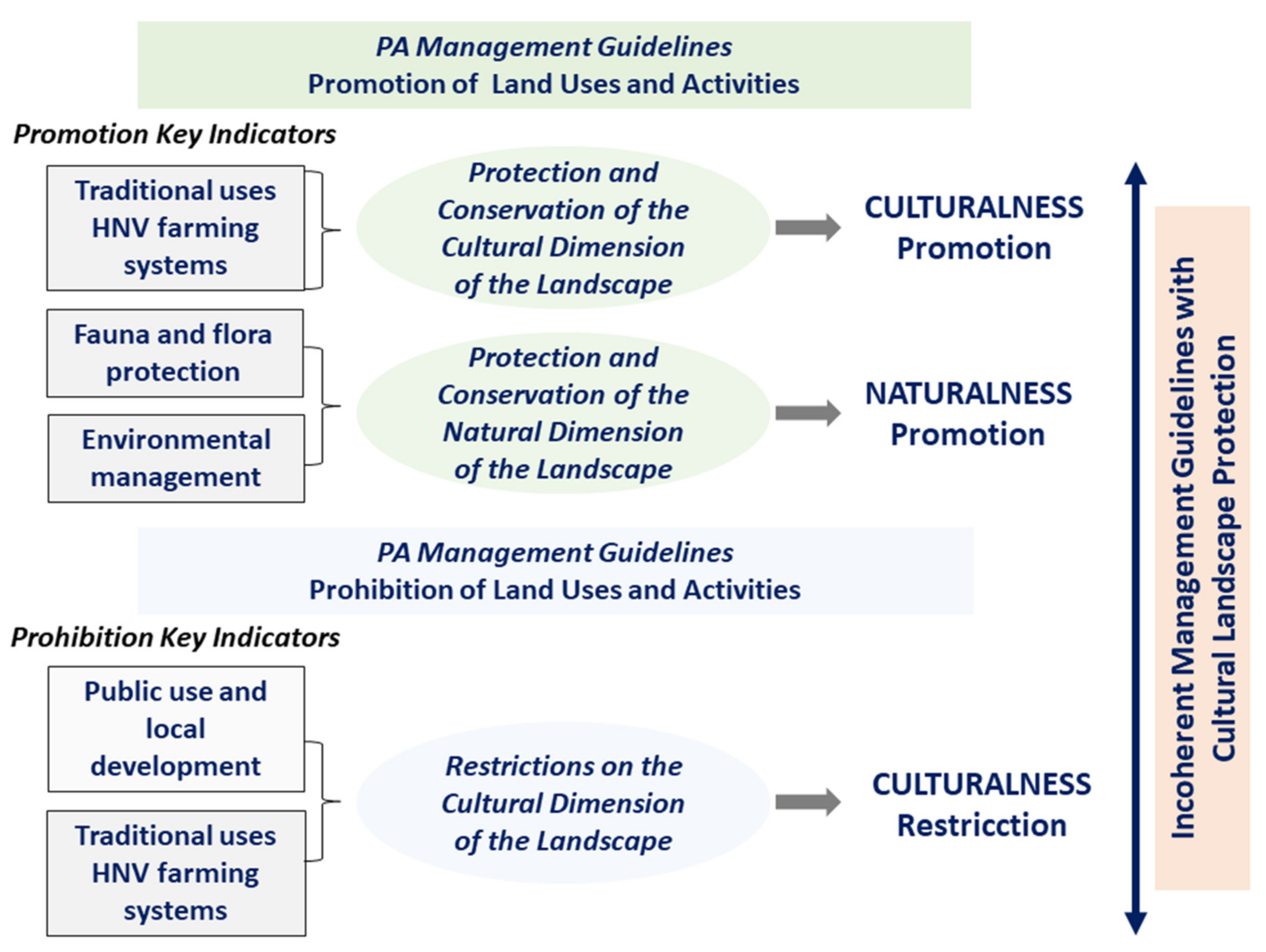
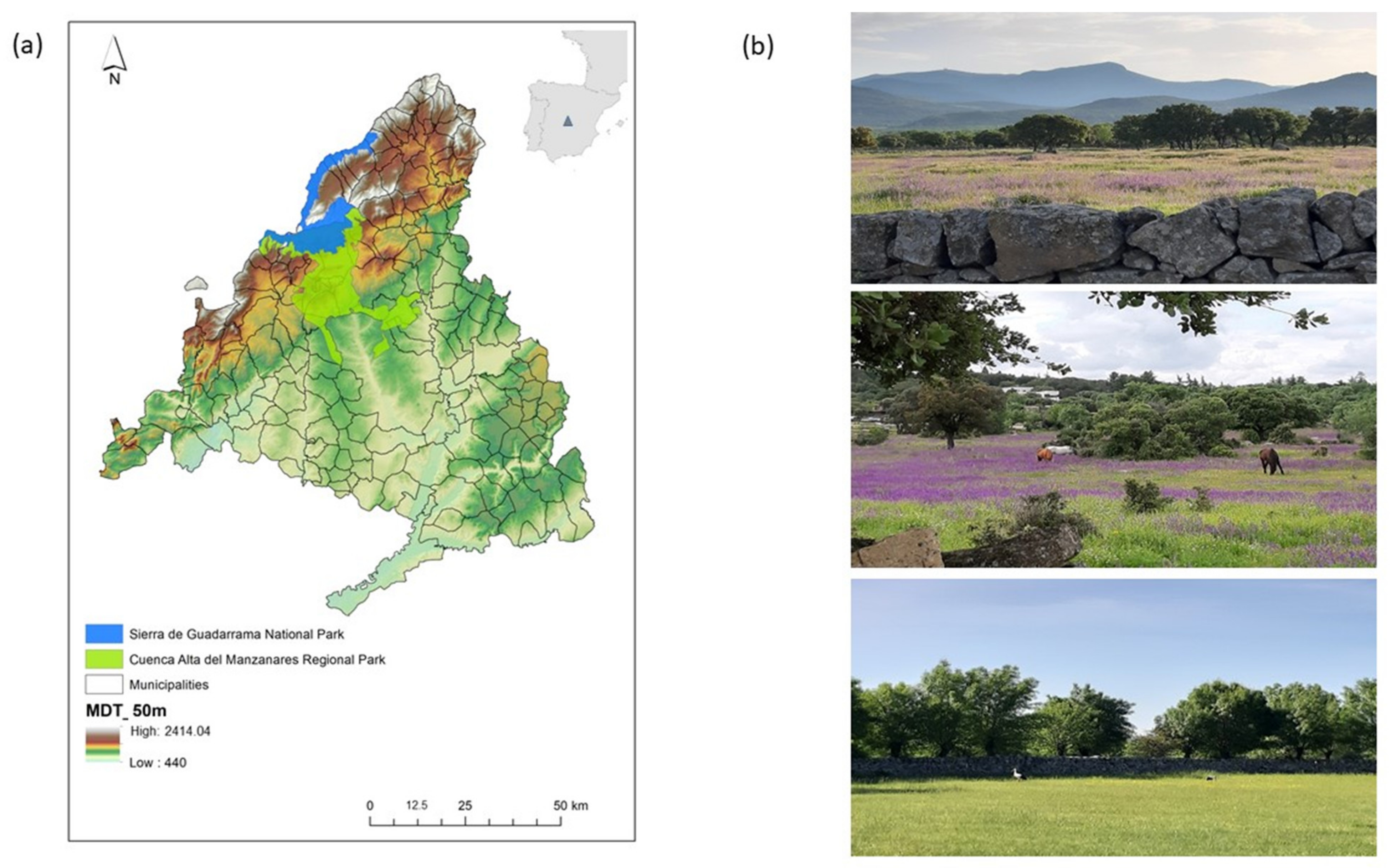
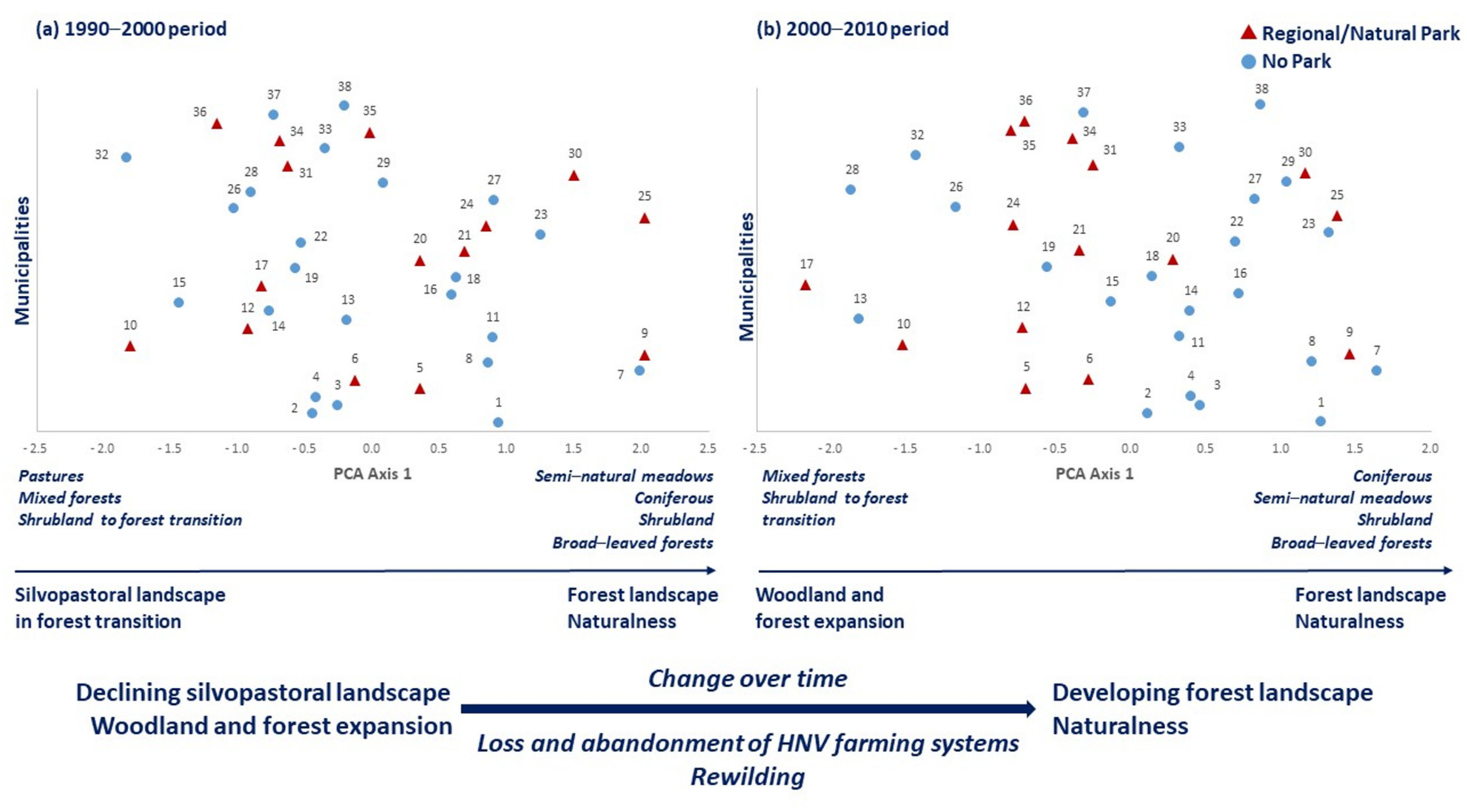
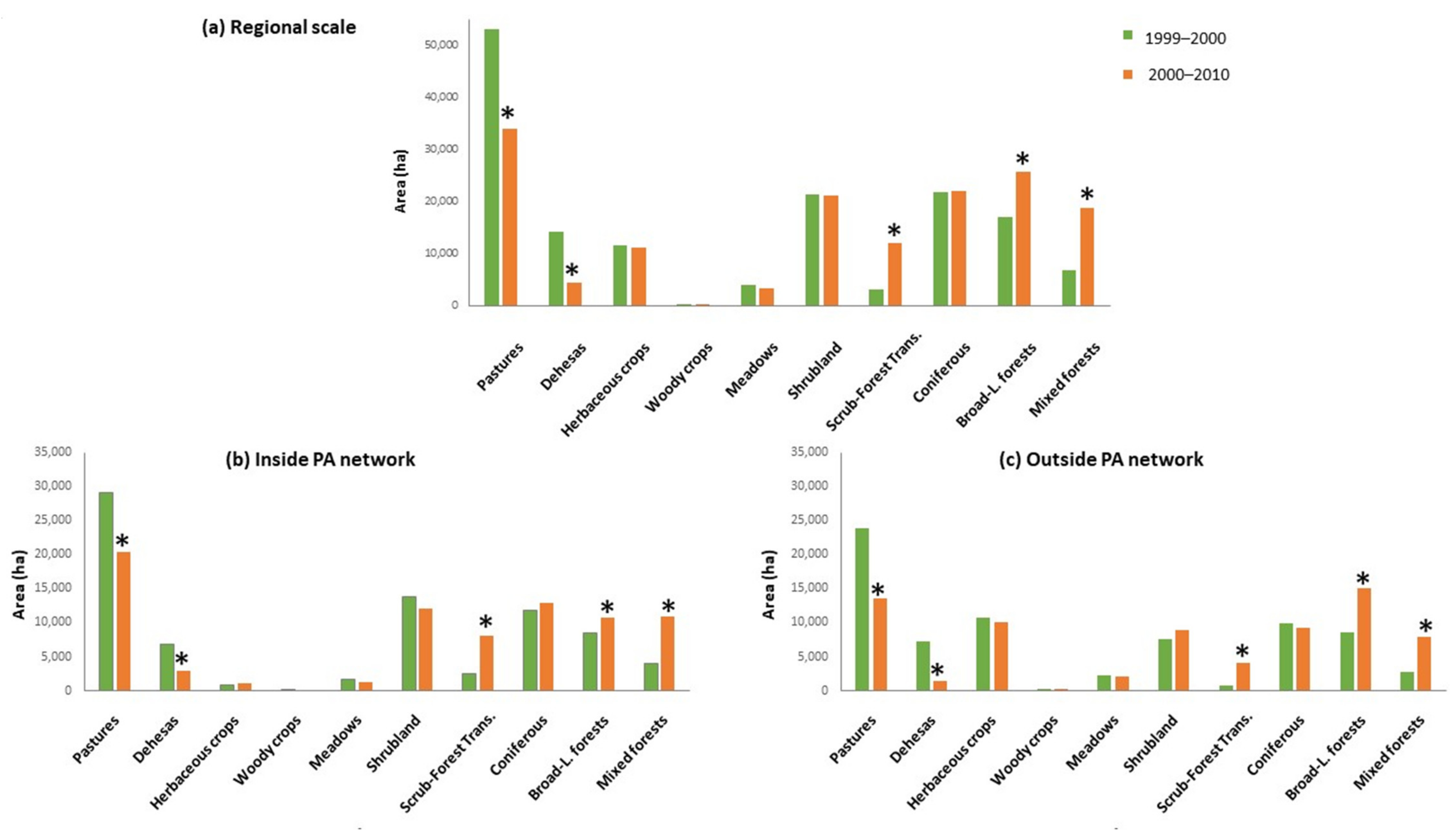
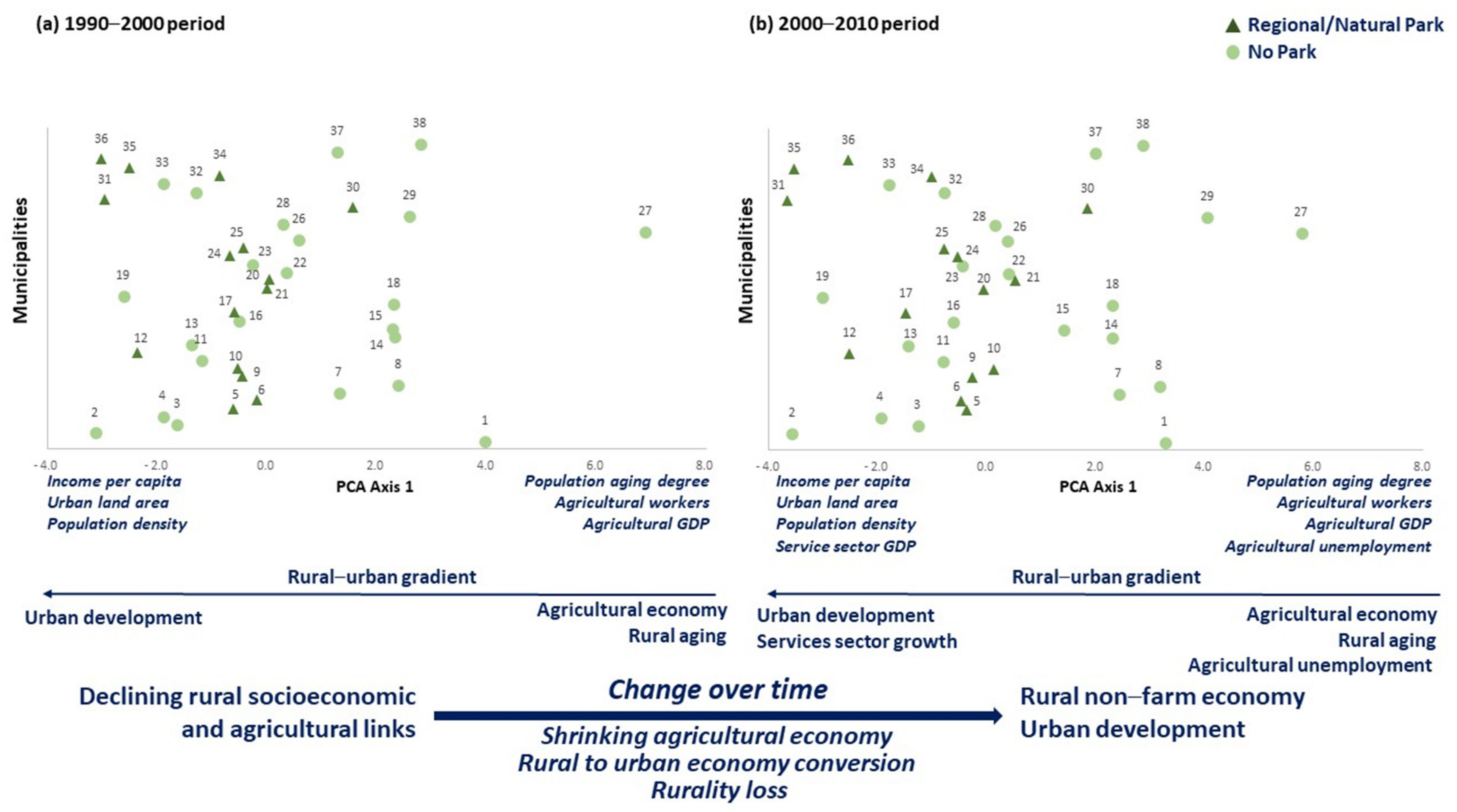

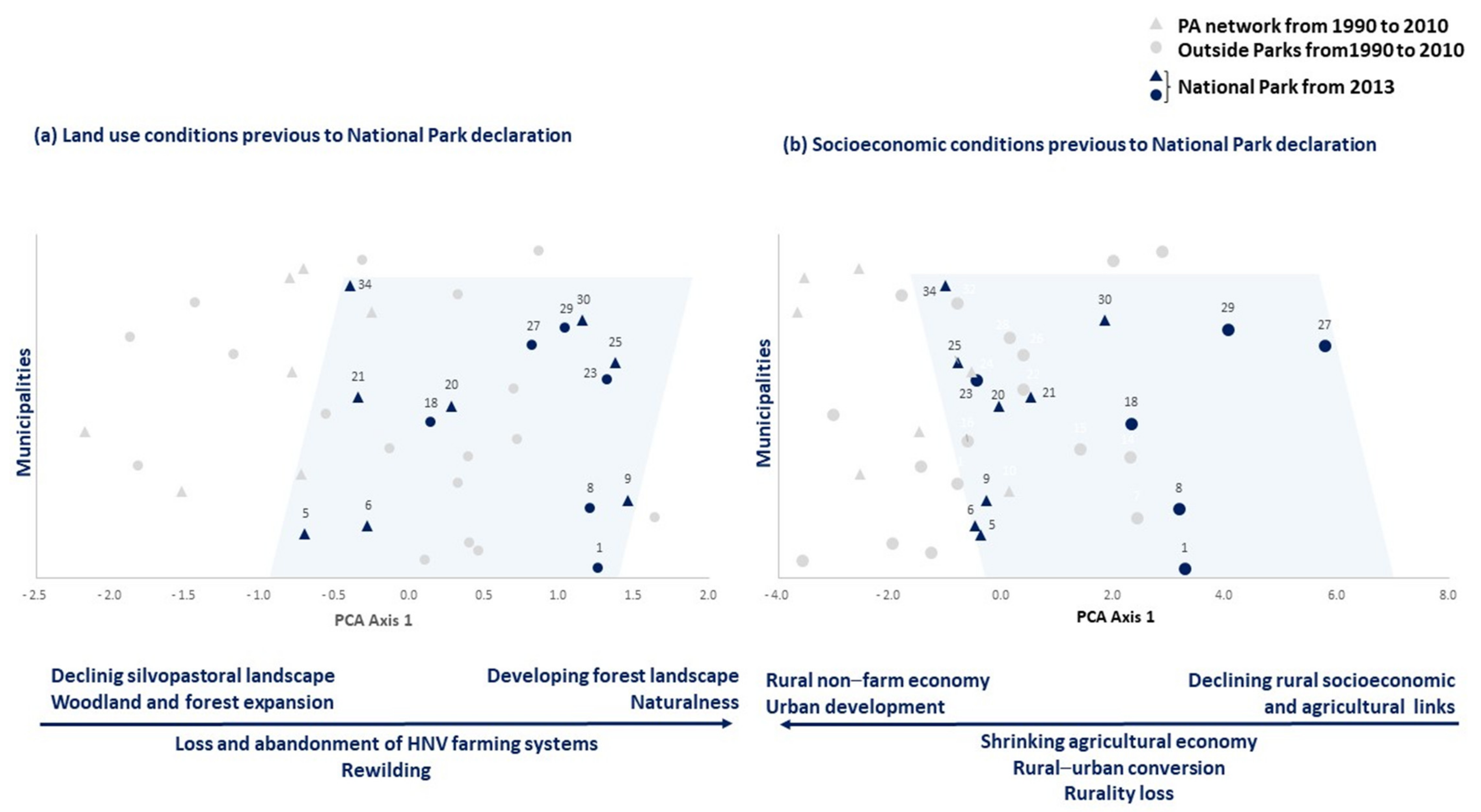
| (a) | ||
|---|---|---|
| Land Use Variables | Description | |
| Pastures | Pastureland; scrub-pastureland mosaics | |
| Dehesas | Open formations with a mixture of pastures and isolated trees. Pastures with broadleaf tree species; pastures with coniferous species; pastures with mosaics of scrub and tree species (broadleaf trees and/or coniferous) | |
| Herbaceous crops | Irrigated herbaceous crops; orchards and forced crops; rainfed herbaceous crops; mosaics of crops and broadleaf tree species | |
| Woody crops | Rainfed olive groves; rainfed vineyard; rainfed mixed crops of olive grove and vineyard; irrigated fruit tree crops; mosaics of crops of fruit trees with conifers | |
| Semi-natural meadows | Semi-natural meadows; mosaics of semi-natural meadows with broadleaf tree species | |
| Shrubland | Mediterranean shrubland dominated by high cover of scrubs of different types and multiple uses (grazing of domestic and wild herbivores, honeybee colonies…) | |
| Systems in scrub-forest transition | Shrubby and woody vegetation. Associations of scrub-coniferous, scrub-broadleaf tree species, scrub-coniferous and broadleaf tree species | |
| Mixed forests | Multi-specific and heterogeneous forests | |
| Broad-leaved forests | Mediterranean broad-leaved sclerophyllous and deciduous forests. Forests of Holm oak (Quercus ilex), Pyrenee oak (Q. pyrenaica), juniper (Juniperus oxycedrus), and different types of scrubs | |
| Coniferous formations | Montane pine forests and plantations of Scots pine (Pinus sylvestris) and black pine (P. nigra) in hillside slopes and pinaster pine (P. pinaster) in the valley bottoms | |
| (b) | ||
| Socioeconomic Variables | Description | Units |
| Population density | Number of inhabitants per km2 | Inhabitants/km2 |
| Population aging | Population of 65 years and over in relation to total population | Percentage |
| Emigration | Number of people that have changed their home outside the municipality in relation to the total population | Percentage |
| Income per capita | Disposable income per capita | Euros |
| Agricultural workers | Number of people working in the agricultural sector in relation to the economically active population | Percentage |
| Agricultural unemployment | Number of unemployed in the agricultural sector in relation to the total of registered unemployed | Percentage |
| Agricultural sector GDP | Gross domestic product from the agricultural sector | Percentage |
| Industrial sector GDP | Gross domestic product from the industrial sector | Percentage |
| Service sector GDP | Gross domestic product from the service sector | Percentage |
| Urban land area | Municipal area that has all urban services | Percentage |
| Agricultural land area | Municipal area dedicated to farmland and pastures | Percentage |
| Land Use Descriptors | PCA-Axis 1 1990–2000 (33.33%) Factor Loadings | PCA-Axis 1 2000–2010 (33.42%) Factor Loadings |
|---|---|---|
| Pastures | −0.531 | −0.268 |
| Dehesas | −0.286 | −0.248 |
| Herbaceous crops | −0.243 | 0.002 |
| Woody crops | −0.166 | 0.115 |
| Semi-natural meadows | 0.767 | 0.591 |
| Shrubland | 0.650 | 0.503 |
| Systems in scrub-forest transition | −0.325 | −0.665 |
| Mixed forests | −0.420 | −0.776 |
| Broad-leaved forests | 0.306 | 0.349 |
| Coniferous formations | 0.705 | 0.653 |
| Socioeconomic Descriptors | PCA-Axis 1 1990–2000 (40.60%) Factor Loadings | PCA-Axis 1 2000–2010 (43.61%) Factor Loadings |
|---|---|---|
| Population density | −0.625 | −0.717 |
| Population aging | 0.929 | 0.843 |
| Emigration | 0.383 | −0.198 |
| Income per capita | −0.857 | −0.885 |
| Agricultural workers | 0.892 | 0.818 |
| Agricultural unemployment | 0.042 | 0.687 |
| Agricultural sector GDP | 0.875 | 0.823 |
| Industrial sector GDP | −0.226 | 0.211 |
| Service sector GDP | −0.265 | −0.507 |
| Urban land area | −0.753 | −0.782 |
| Agricultural land area | −0.286 | 0.136 |
Publisher’s Note: MDPI stays neutral with regard to jurisdictional claims in published maps and institutional affiliations. |
© 2021 by the authors. Licensee MDPI, Basel, Switzerland. This article is an open access article distributed under the terms and conditions of the Creative Commons Attribution (CC BY) license (https://creativecommons.org/licenses/by/4.0/).
Share and Cite
Schmitz, M.F.; Arnaiz-Schmitz, C.; Sarmiento-Mateos, P. High Nature Value Farming Systems and Protected Areas: Conservation Opportunities or Land Abandonment? A Study Case in the Madrid Region (Spain). Land 2021, 10, 721. https://doi.org/10.3390/land10070721
Schmitz MF, Arnaiz-Schmitz C, Sarmiento-Mateos P. High Nature Value Farming Systems and Protected Areas: Conservation Opportunities or Land Abandonment? A Study Case in the Madrid Region (Spain). Land. 2021; 10(7):721. https://doi.org/10.3390/land10070721
Chicago/Turabian StyleSchmitz, María F., Cecilia Arnaiz-Schmitz, and Patricio Sarmiento-Mateos. 2021. "High Nature Value Farming Systems and Protected Areas: Conservation Opportunities or Land Abandonment? A Study Case in the Madrid Region (Spain)" Land 10, no. 7: 721. https://doi.org/10.3390/land10070721
APA StyleSchmitz, M. F., Arnaiz-Schmitz, C., & Sarmiento-Mateos, P. (2021). High Nature Value Farming Systems and Protected Areas: Conservation Opportunities or Land Abandonment? A Study Case in the Madrid Region (Spain). Land, 10(7), 721. https://doi.org/10.3390/land10070721








